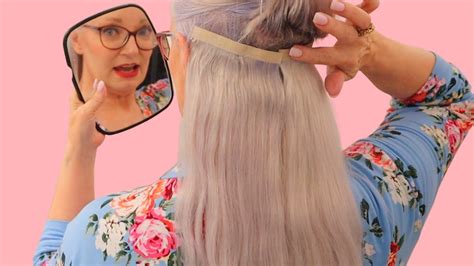Introduction:

Aging is a natural process that can lead to changes in our hair, including thinning and hair loss. For women with thin, short hair, this can be a source of frustration and self-consciousness. However, there is a solution: hair extensions.
Benefits of Hair Extensions for Older Women
Hair extensions offer a wide range of benefits for older women with thinning hair:
- Increased volume and fullness: Extensions add instant volume and fullness to thin hair, creating the illusion of thicker, healthier hair.
- Enhanced confidence and self-esteem: Thicker, fuller hair can boost confidence and self-esteem, making women feel more confident in their appearance.
- Hair loss coverage: Extensions can effectively cover up areas of hair loss or thinning, creating a more uniform and natural-looking appearance.
- Versatile styling options: Extensions allow for a wide range of styling options, from long and flowing to short and sassy. This versatility gives women the freedom to experiment with different looks.
- Damage protection: Extensions can act as a protective barrier between natural hair and styling products, reducing damage and breakage.
Types of Hair Extensions
There are several different types of hair extensions available, including:
- Clip-in extensions: These are the easiest and most temporary type of extensions. They simply clip into the hair and can be removed at any time.
- Tape-in extensions: These extensions are attached to the hair with adhesive tape. They are more permanent than clip-ins but can still be removed by a professional.
- Fusion extensions: These extensions are attached to the hair using heat or glue. They are the most permanent type of extension and can last for several months.
Choosing the Right Extensions
When choosing hair extensions, it is important to consider the following factors:
- Hair texture: Extensions should match the texture of your natural hair as closely as possible to ensure a natural appearance.
- Hair length: Extensions should be the desired length or slightly longer to allow for trimming.
- Hair color: Extensions should match your natural hair color or be a slightly lighter or darker shade for a more natural blend.
- Lifestyle: Consider your lifestyle and daily routine when selecting extensions. Some types, such as tape-ins, require more maintenance than others.
Installation and Maintenance
Professional installation is recommended for all types of hair extensions. A trained stylist will ensure that the extensions are properly attached and blended with your natural hair.
Regular maintenance is essential to ensure the longevity and health of your hair extensions. This includes:
- Brushing and detangling: Brush your hair extensions gently to remove tangles and prevent matting.
- Washing and conditioning: Wash and condition your extensions regularly, using products specifically designed for extensions.
- Trimming: Trim your extensions as needed to maintain a healthy and natural appearance.
Side Effects and Risks
While hair extensions are generally safe, there are potential side effects and risks to consider:
- Traction alopecia: Excessive pulling on the hair during installation or removal can lead to traction alopecia, a form of hair loss.
- Allergic reactions: Some people may experience allergic reactions to the adhesives used in tape-in or fusion extensions.
- Scalp irritation: Extensions can cause scalp irritation in some people, especially if they are not properly installed or maintained.
Conclusion
Hair extensions can be a transformative solution for older women with thinning short hair. They offer a range of benefits, including increased volume, enhanced confidence, and hair loss coverage. By carefully choosing the right extensions and following proper installation and maintenance techniques, you can enjoy the benefits of thicker, fuller hair for years to come.
Additional Tips for Older Women with Thinning Hair
In addition to hair extensions, there are several other things that older women can do to improve the appearance of their hair:
- Use volumizing products: Volumizing shampoos, conditioners, and styling products can add volume and fullness to thin hair.
- Get regular trims: Regular trims remove split ends and damaged hair, promoting healthy hair growth.
- Avoid heat styling: Excessive heat styling can damage hair and make it more prone to breakage. Use heat protectant products and limit the use of heat styling tools.
- Eat a healthy diet: A healthy diet rich in protein, vitamins, and minerals can promote healthy hair growth.
- Consult a dermatologist: If you are experiencing excessive hair loss or thinning, consult a dermatologist to rule out any underlying medical conditions.
